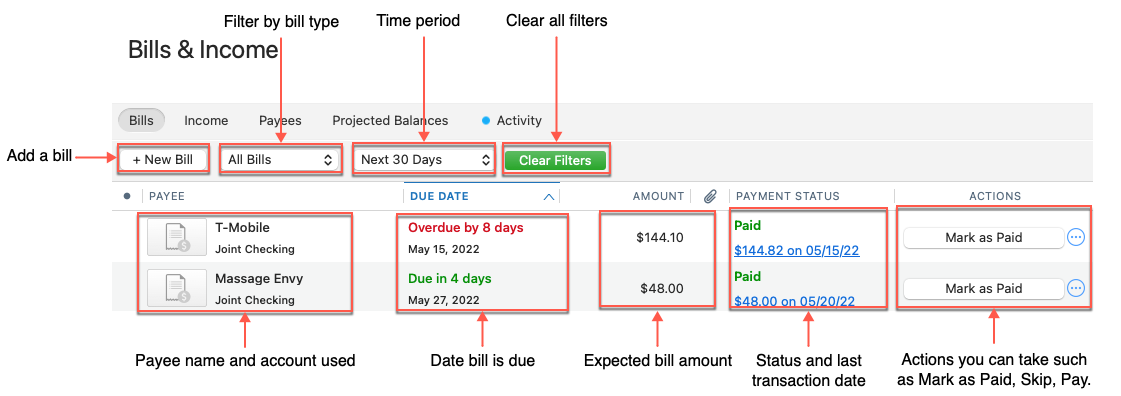Bills & Income - Mac

The Bills view is designed to act as a checklist for your upcoming bills and a place to review your bill activity. There are three main areas of the view:
Filter Bar
- New Bill - Walk through the steps to pay a bill using Quicken or track a bill.
- Bill Type - Filter the list to see only a specific type of bill.
- All Bills - View all types of bills. This is the default.
- eBills - View only eBills.
- Manual Bills - View scheduled bills that are neither an eBill nor bill pay.
- Bill Pay Bills - View Bill Pay bills. These are bills that are paid from within Quicken using Bank Bill Pay.
- Time Period - Filter the list based on the time period.
- Next Instance - View the next instance of all upcoming bills, independent of the time period.
- Next 7 Days - View all bills that are going to be paid in the upcoming 7 days.
- Next 14 Days - View all bills that are going to be paid in the upcoming 14 days.
- Next 30 Days - View all bills that are going to be paid in the upcoming 30 days. This is the default period.
- Next 60 Days - View all bills that are going to be paid in the upcoming 60 days.
- Next 6 Months - View all bills that are going to be paid in the upcoming 6 months.
- Next 1 Year - View all bills that are going to be paid in the upcoming year.
- Clear Filters - Clear the filters and set them back to their defaults.
Upcoming Bill list
The upcoming bill list shows you all the bills that will be paid in the coming month or whatever period is defined. This list is ordered by date, with the bills coming due soonest at the top. Bills, by definition, are scheduled transactions that have a negative amount. The bills list has a number of elements:
- Payee - The name of the biller being paid. On the second line, you'll see the account from which the bill is being paid.
- Due Date - When the bill is due or the date when it will be paid.
- Amount - The amount of the bill due.
- Payment Status: See Quick Pay Payment Status or Learn about Check Pay for more information.
- Schedule: Frequency that bill occurs.
- Action Buttons - The action button changes depending on the type of bill and the state of the bill.
- Auto Enter - There is no action button if the bill is set to Mark as Paid automatically on the scheduled date. The words Auto Enter appear.
- Mark as Paid - If the bill isn't set to be auto-entered, then this button is available. Clicking it will convert the scheduled transaction to an actual transaction in the register.
- Pay Now - Bill Pay items that have not been sent yet have the Pay Now button. Clicking it will "send" the payment request to the Bank Bill Pay service for payment. It won't actually be paid now but will be paid on the designated date.
- Menu - Click on the three dots to get to the Bill menu.
- Pay Now: Pay the bill using your usual payment service (Quick Pay, Check Pay, Bank Bill Pay).
- Mark as Paid: Mark Bill as paid.
- Edit and Mark as Paid: Edit the details (Scheduled Date, Category, Tag, Memo) for a single payment and mark it as paid.
- Skip this Instance - Skip this instance of the bill. You may do this if the bill was paid by someone else.
- Pay with Bank Bill Pay
- Pay with Quick Pay: Use the Quicken Quick Pay service to pay the bill.
- Pay with Check Pay: Use the Quicken Check Pay service to pay the bill.
- Edit this Instance: Edit the details (Scheduled Date, Category, Tag, Memo) for a single payment.
- Edit All Instances - Edit the details (Scheduled Date, Recurrence, Category, Tag, Memo) of the bill.
- Link eBill: Convert a manual bill into an online bill by linking to the biller's website.
- Unlink eBill: Convert a linked bill to a manual bill.
- Delete Series - Delete all future transaction reminders.
More information
